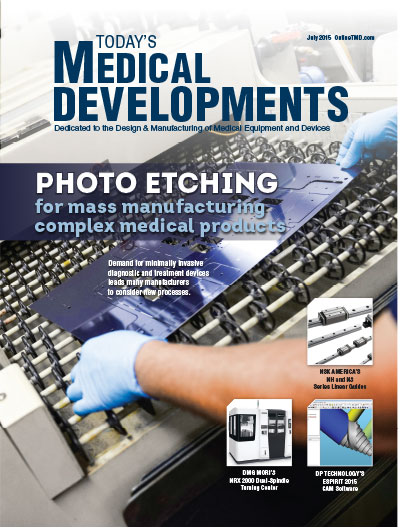 When a patient receives a new hip, it is usually adjusted only approximately to leg length, so the leg can be longer or shorter. A new type of measurement method,developed by the Fraunhofer Institute for Machine Tools and Forming Technology (IWU), coupled with a modular implant, should allow orthopedic surgeons to precisely calibrate leg length after the operation to match its original length.
When a patient receives a new hip, it is usually adjusted only approximately to leg length, so the leg can be longer or shorter. A new type of measurement method,developed by the Fraunhofer Institute for Machine Tools and Forming Technology (IWU), coupled with a modular implant, should allow orthopedic surgeons to precisely calibrate leg length after the operation to match its original length.
To measure the patients’ leg length, the doctor affixes a small plastic box containing two LEDs to the patient’s shin. The doctor then takes hold of the patient’s heel and lifts it. With that motion, the two lights trace an arc that is recorded by a camera positioned about 1.5m to the side of the patient.
The principle is similar a compass. If the leg becomes shorter or longer, that will change the arc traced by the LEDs. The doctor takes this measurement twice – once right before the operation and once after the implant has been temporarily inserted. The box remains on the leg during the operation. Software compares both arcs to determine if the leg is the same length it was before the procedure, and if necessary, the doctor can make adjustments to the artificial hip.
Testing of a measuring system prototype has been successful at the Leipzig University hospital. There are plans for a clinical trial later this year, and the new system could be on the market in about two years.
Fraunhofer’s researchers also optimized the hip implants by replacing prefabricated implants in various sizes with modular system. The doctor can select the right hip stem and neck for each patient. Special screw connections attach the individual parts to each other, and the combined unit is implanted in the hip for testing. The doctor then measures the leg length, and can separate the implant’s various components to exchange them for better-fitting parts or adjust them as required.
The new hip implants are less prone to breakage than conventional models with a conical clamping ring. Specialized screws hold the parts of the new implants together. The point where they connect is mechanically stable, preventing breakage.
Fraunhofer-Gesellschaft
www.fraunhofer.de

Explore the July 2015 Issue
Check out more from this issue and find you next story to read.
Latest from Today's Medical Developments
- Lumetric's Scanning Tubing Measurement System
- Latest advancements in machine tool technology
- Visit Okuma America at IMTS 2024
- March 2024 USMTO orders were $354.7 million
- AM for Aircraft Cockpit Interior Components
- Arizona WearTech Center member receives new patent
- SABIC showcased progress in plastic innovation
- Ink for 3D-printing flexible devices, no mechanical joints





